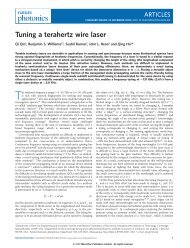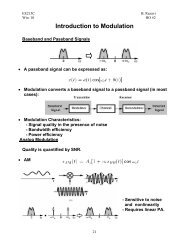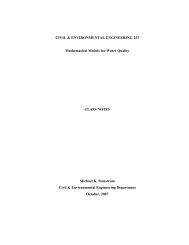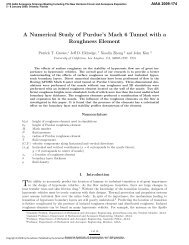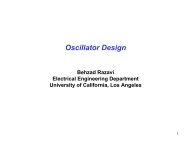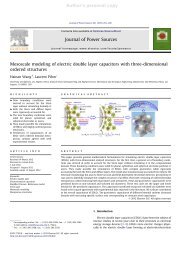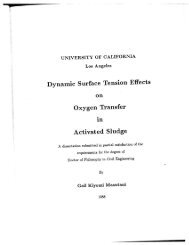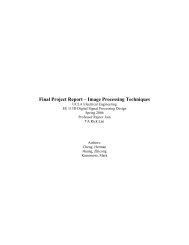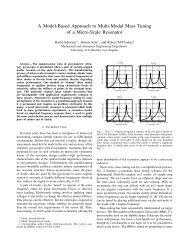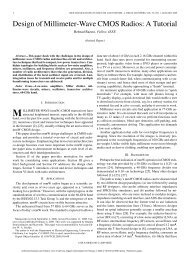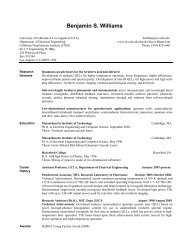motion of bubbles and bubble characterstics - UCLA Engineering
motion of bubbles and bubble characterstics - UCLA Engineering
motion of bubbles and bubble characterstics - UCLA Engineering
You also want an ePaper? Increase the reach of your titles
YUMPU automatically turns print PDFs into web optimized ePapers that Google loves.
1.0 MOTION OF BUBBLES AND BUBBLE CHARACTERSTICS<br />
1.1 Bubble Formation<br />
1.11 Size<br />
Formation is generally accomplished by passing air through an orifice. Bubble volume<br />
has been empirically determined as<br />
2πRσ<br />
VB<br />
=<br />
gΔρ<br />
(1)<br />
<strong>and</strong> radius<br />
13<br />
⎛3Rσ<br />
⎞<br />
a = ⎜ ⎟<br />
⎝2 Δρg⎠<br />
(2)<br />
where V B = <strong>bubble</strong> volume (ml or cm 3 )<br />
a = <strong>bubble</strong> radius, cm<br />
R = orifice radius, cm<br />
σ = surface tension, dynes/cm<br />
g = gravitational constant, cm/sec 2<br />
Δρ = difference between ρ, density <strong>of</strong> liquid in gram/cm 3 , <strong>and</strong> ρ p , the<br />
density <strong>of</strong> the <strong>bubble</strong>.<br />
Accordingly, the radius <strong>of</strong> a <strong>bubble</strong> is directly proportional to the surface tension <strong>and</strong> the<br />
radius <strong>of</strong> the orifice, <strong>and</strong> inversely proportional to the difference in densities between the<br />
liquid <strong>and</strong> gas. Temperature <strong>and</strong> viscosity have only marginal effects on <strong>bubble</strong><br />
diameters.<br />
1.12 Effect <strong>of</strong> Gas Flow Rate.<br />
Bubble size is fairly constant at low <strong>and</strong> medium gas flow rates where equations 1 <strong>and</strong> 2<br />
apply but increases dramatically at high gas flow rates, <strong>and</strong> equations 1 <strong>and</strong> 2 are no<br />
longer valid.<br />
air flow rate<br />
Over the range <strong>of</strong> air rates normally encountered in aeration practice, the frequency <strong>of</strong><br />
<strong>bubble</strong> formation is nearly constant <strong>and</strong> the <strong>bubble</strong> radius increases to account for the<br />
larger flow rate. The mean radius <strong>of</strong> the <strong>bubble</strong> produced can be modeled as an<br />
exponential function <strong>of</strong> the gas flow rate, a ~ G s n where a is the radius, G s is the air flow<br />
rate, <strong>and</strong> n, the exponent, ranges from 0.1 to 0.44.
1.13 Coalescence<br />
There are two types <strong>of</strong> liquids from the point <strong>of</strong> view <strong>of</strong> <strong>bubble</strong> formation:<br />
Class A: Bubbles formed will not recombine with adjacent <strong><strong>bubble</strong>s</strong> Examples are<br />
aqueous solutions <strong>of</strong> alcohols, organic acids, ether, benzene, concentrated<br />
HNO 3 <strong>and</strong> strong salt solutions.<br />
Class B: Bubbles have a strong tendency to combine or coalesce. Examples are all<br />
viscous liquids, e.g., olive oil, tap or distilled H 2 O, dilute salt solutions,<br />
<strong>and</strong> H 2 SO 4 in all concentrations.<br />
Seawater is a good example. The transition from coalescence to non-coalescence (Class<br />
B to Class A) is 8 to 10 g/L. Therefore in tap water the <strong><strong>bubble</strong>s</strong> coalesce <strong>and</strong> in sea water<br />
the <strong><strong>bubble</strong>s</strong> would not recombine. You can observe this phenomenon by visiting a<br />
tropical fish store with both fresh <strong>and</strong> salt water aquariums. The <strong><strong>bubble</strong>s</strong> are much<br />
smaller in the salt water aquariums. Another example are “white caps” in salt water <strong>and</strong><br />
the absence <strong>of</strong> such foaming on freshwater lakes.<br />
1.2 Bubble Shape<br />
Bubble shape varies with the diameter <strong>and</strong> this is caused by the varying drag forces.<br />
Radius < 0.01 cm<br />
Radius 0.01 to 0.1 cm<br />
Radius > 0.1 cm<br />
solid spheres<br />
deviational from spherical<br />
ellipsoidal<br />
1.3 Motion <strong>and</strong> Velocity <strong>of</strong> Bubbles<br />
The regime <strong>of</strong> <strong>bubble</strong> <strong>motion</strong> varies considerably with the Reynolds number,<br />
R e = Ua<br />
γ<br />
(3)<br />
where U = <strong>bubble</strong> rise velocity<br />
a = <strong>bubble</strong> radius<br />
γ = kinematic viscosity <strong>of</strong> fluid<br />
1. For R e < 1<br />
a < 0.01 cm Stokes Law Regime<br />
2<br />
1⎛ga<br />
⎞<br />
U = ⎜ 3 ⎝<br />
γ ⎟<br />
⎠<br />
where g is the gravity constant.<br />
(4)<br />
Bubbles rise vertically without oscillating.<br />
2. For 1 < R e < 800 which occurs for <strong>bubble</strong> radii from 0.01 cm to 0.1 cm.<br />
ga<br />
U~2 0.9<br />
(5)
Bubbles move in a helical fashion.<br />
3. For R e = 800 <strong>and</strong> a > 0.1 cm<br />
Bubbles are ellipsoidal in shape, <strong>motion</strong> is irregular, <strong>and</strong> velocity is independent <strong>of</strong><br />
<strong>bubble</strong> diameter (U is approx. 28 - 30 cm/sec) for <strong><strong>bubble</strong>s</strong> having radii up to 0.75 cm.<br />
For larger <strong><strong>bubble</strong>s</strong> their velocity tends to increase to 35 - 40 cm/sec, but they are not<br />
stable <strong>and</strong> tend to subdivide into smaller <strong><strong>bubble</strong>s</strong>.<br />
U (cm/sec)<br />
40<br />
30<br />
20<br />
10<br />
0<br />
0.5 1.0<br />
<strong>bubble</strong> diameter, cm<br />
This should give a semi-quantitative indication <strong>of</strong> the size <strong>of</strong> <strong><strong>bubble</strong>s</strong> that are formed <strong>and</strong><br />
the rise velocity as a function <strong>of</strong> size. Unfortunately the number <strong>of</strong> <strong><strong>bubble</strong>s</strong> expelled as a<br />
function <strong>of</strong> gas flow rate cannot be quantitatively described, <strong>and</strong> empirical methods must<br />
be utilized.<br />
2.0 EFFECT OF TEMPERATURE ON OXYGEN TRANSFER<br />
Aeration, mass transfer coefficients are influenced by temperature due to the effect on the<br />
diffusivity <strong>and</strong> viscosity.<br />
or<br />
K<br />
T −20<br />
L<br />
= KL 20⋅θ (6)<br />
T −20<br />
L<br />
= KLa20θ (7)<br />
K a<br />
Reported values <strong>of</strong> θ range from 1.012 to 1.04. The most reliable estimates are 1.020 for<br />
diffused aeration <strong>and</strong> 1.028 for surface aeration. The ASCE st<strong>and</strong>ard uses 1.024, <strong>and</strong> this<br />
value must be used when doing a st<strong>and</strong>ard test. The rate <strong>of</strong> increase in K L a with<br />
temperature is greater than the increase in the rate <strong>of</strong> oxygen diffusivity due to the<br />
decrease in water viscosity with increasing temperature.<br />
3.0 EFFECT OF SURFACE ACTIVE IMPURITIES ON GAS TRANSFER<br />
Many organic substances present in sewage are surface active, that is, they tend to adsorb<br />
or accumulate at the liquid-solid or liquid-gas interface. These compounds are called<br />
surfactants. Soaps <strong>and</strong> detergents are the most common. Surfactants have polar <strong>and</strong> non-
polar parts <strong>of</strong> the molecule. The simplest has a polar end, <strong>of</strong>ten charged, <strong>and</strong> a non polar<br />
end, such as a hydrocarbon. The most common surfactant is soap, which was originally<br />
manufactured by mixing animal fat <strong>and</strong> lye (sodium hydroxide). The result is a<br />
surfactant with a negatively charged end (the sodium is released to solution as the<br />
balancing cation). Hydrogen bonding among water molecules will gradually force the<br />
surfactant’s non polar end to the surface. This happens because the polar ends <strong>of</strong> the<br />
water molecules attract each other, <strong>and</strong> squeeze the surfactant out <strong>of</strong> the way. The result<br />
is the surfactant at the interface (e.g., the air <strong>bubble</strong> surrounded by water) with the polar<br />
or charge end in the water <strong>and</strong> the non polar end protruding into the <strong>bubble</strong>. The net<br />
effect is to reduce oxygen transfer in the area around the <strong>bubble</strong> by reducing molecular<br />
diffusion <strong>of</strong> oxygen.<br />
The time required for adsorption varies with the surfactant type. Small surfactants such<br />
as acetic acid adsorb quickly. The time to reach equilibrium depends upon many<br />
different properties, but is inversely proportional the molecular weight <strong>of</strong> the surfactant.<br />
The excess surface concentration can be calculated. For a small concentration, C, in the<br />
bulk phase the surface excess can be calculated as follows:<br />
where R = universal gas constant<br />
T = absolute temperature<br />
Γ = surface excess (moles/cm 3 )<br />
C = concentration <strong>of</strong> solute<br />
σ = surface tension<br />
C dσ<br />
Γ=− (8)<br />
RT dC<br />
Basically there are four effects <strong>of</strong> surface active agents (SAA) on gas transfer:<br />
1. The adsorbed film, which may partially or totally cover the water surface <strong>and</strong> thus<br />
act as an insulating membrane separating the gas <strong>and</strong> the aqueous phase. An oil<br />
sheen is an example. This effect increases resistance to gas transfer.<br />
hydrophobic<br />
Air<br />
hydrophillic<br />
- - - - -<br />
+ + + + +<br />
Water<br />
2. Water in a pure state generally consists <strong>of</strong> aggregates <strong>of</strong> 4 to 8 molecules <strong>of</strong> water<br />
that are in a state <strong>of</strong> dynamic equilibrium. When SAA molecules are introduced<br />
to the pure water, they tend to affect the water structure by stabilizing the more
ordered arrangements. The SAA molecules anchored to the water surface with<br />
their hydrophilic ends will acting like magnet heads that immobilize several<br />
layers <strong>of</strong> crystalline water structures <strong>and</strong> attract a blanket <strong>of</strong> counter ions. This<br />
surface hydration layer, may extend several thous<strong>and</strong> angstroms into the aqueous<br />
phase, which eliminates r<strong>and</strong>om surface <strong>motion</strong> (i.e., encourages surface<br />
stagnation).<br />
3. Surface active agents can influence <strong>bubble</strong> dynamics. During the <strong>bubble</strong> rise the<br />
SAA film adsorbed on the <strong>bubble</strong> wall will be driven to the trailing end <strong>of</strong> the<br />
<strong>bubble</strong> where it condenses, forming a solid cap. As a result a surface force will<br />
be set in the direction <strong>of</strong> the front end <strong>of</strong> the <strong>bubble</strong>, opposing the liquid drag<br />
forces which may cause a retardation in the velocity <strong>of</strong> <strong>bubble</strong> rise.<br />
π = surface pressure<br />
π<br />
π<br />
30<br />
Dist. H 2 O<br />
U (cm/sec)<br />
20<br />
10<br />
0<br />
0.5 1.0<br />
Bubble diameter, cm<br />
w/ SAA<br />
4. Diffusers produce smaller <strong><strong>bubble</strong>s</strong> in the presence <strong>of</strong> surfactants. Larger <strong><strong>bubble</strong>s</strong><br />
with R e > 800 undergo fragmentation in the presence <strong>of</strong> SAA. The smaller<br />
<strong><strong>bubble</strong>s</strong> have greater surface area per unit volume <strong>of</strong> gas supplied, which<br />
increases gas transfer rate.<br />
3.1 Combined Effects on K L a <strong>and</strong> K L<br />
The following figure shows the combination <strong>of</strong> all effects.
2.0<br />
1.5<br />
K L a<br />
&<br />
K L<br />
1.0<br />
CMC<br />
K L a<br />
K L<br />
0.5<br />
0<br />
20<br />
100 200 300<br />
SAA concentration<br />
The addition <strong>of</strong> a small amount <strong>of</strong> SAA reduces the transfer coefficient to a minimum<br />
value, which generally occurs at a surfactant concentration corresponding to the critical<br />
micelle concentration (CMC). The CMC is the lowest concentration where colloidal<br />
aggregates <strong>of</strong> the surfactant form as a result <strong>of</strong> association <strong>of</strong> individual molecules or ions<br />
with one another. Below this concentration the properties <strong>of</strong> the solution are similar to<br />
those <strong>of</strong> solutions <strong>of</strong> ordinary electrolytes. Above this concentration the solution behaves<br />
differently in that changes in such properties as surface tension are much less marked<br />
with increasing concentration.<br />
The gas transfer coefficient, K L , remains constant at a minimum value upon addition <strong>of</strong><br />
surfactant above the CMC for the <strong>bubble</strong> aeration. The overall transfer coefficient, K L a,<br />
may increase for increasing levels <strong>of</strong> surfactant above the CMC due to the creation <strong>of</strong> a<br />
greater exposed interfacial <strong>bubble</strong> or droplet area for transfer (smaller <strong><strong>bubble</strong>s</strong> or<br />
droplets).<br />
3.2 Effects <strong>of</strong> Surfactants on Process Water<br />
The effect <strong>of</strong> surfactants is <strong>of</strong>ten quantified using an empirical coefficient called an<br />
α factor.<br />
KLa <strong>of</strong> test solution<br />
α =<br />
(9)<br />
K a <strong>of</strong> tap water<br />
L<br />
Under laminar (quiescent) conditions there may be little effect <strong>of</strong> surfactants on α since<br />
resistance from bulk diffusion may exceed the combined interfacial resistances. For<br />
moderately turbulent conditions significant reduction in α occurs, since the interfacial
esistance to molecular diffusion <strong>of</strong> the adsorbed surfactant molecules controls gas<br />
transfer rate. At high degrees <strong>of</strong> turbulence the value <strong>of</strong> α may increase due to the high<br />
surface renewal rates. The high renewal prevents adsorption equilibrium at the interface;<br />
the surfactants do not have time to accumulate on the interface, because the interface is<br />
replaced or swept from the system too quickly. Values <strong>of</strong> α greater than unity may result<br />
from very high turbulence due to an increased interfacial surface area; the reduction in<br />
diffusion rate is more than compensated by the increase in interfacial surface area due to<br />
the smaller <strong><strong>bubble</strong>s</strong>. Such conditions are rarely observed in full scale tests or treatment<br />
plants, but are easy to produce in small, lab-scale reactors.<br />
3.3 Correlation <strong>of</strong> Bubble Aeration Data<br />
Eckenfelder (1959) showed that for any aeration depth, oxygen transfer characteristics<br />
can be correlated according to the dimensionless Sherwood, Reynolds <strong>and</strong> Schmidt<br />
numbers, as follows:<br />
where<br />
U = <strong>bubble</strong> velocity<br />
ν = kinematic viscosity<br />
K L d B<br />
= Sherwood number (S<br />
D<br />
h )<br />
dBU<br />
= Reynolds number (R e )<br />
ν<br />
D<br />
ν<br />
= Schmidt number (S c )<br />
KLdB<br />
⎛dBU⎞⎛ ν ⎞<br />
=f<br />
D<br />
⎜ ⎜ ⎟<br />
ν<br />
⎟ (10)<br />
⎝ ⎠ ⎝ D ⎠<br />
For greater aeration depths Eckenfelder applied an exponential depth factor to<br />
compensate for the end effects (formation <strong>and</strong> bursting <strong>of</strong> <strong>bubble</strong>).<br />
KLdB<br />
H<br />
13 f R e S c<br />
D<br />
( )( ) 12<br />
= (11)<br />
End effects may also be corrected for by correlating the coefficient, F, against depth.<br />
When evaluating the performance <strong>of</strong> commercial aeration equipment, one generally<br />
considers the volumetric mass transfer coefficient, K L a.<br />
⎛# <strong><strong>bubble</strong>s</strong> ⎞⎛ area ⎞ Gs<br />
2 6G<br />
Area per minute= = ×πd<br />
B<br />
= s<br />
⎜ ⎟⎜ ⎟<br />
⎝ min ⎠⎝<strong>bubble</strong> ⎠ ⎛π<br />
⎞ 2 dB<br />
⎜ ⎟dB<br />
⎝6<br />
⎠<br />
(12)
tank depth H<br />
Contact time <strong>of</strong> <strong>bubble</strong> in tank = =<br />
U U<br />
Total surface area in tank <strong>of</strong> any time is therefore:<br />
6Gs<br />
H<br />
= (13)<br />
dB<br />
U<br />
6G<br />
<strong>and</strong> ratio (A/V) is :<br />
sH<br />
(14)<br />
dUV<br />
s<br />
Solving equation (11) for K L <strong>and</strong> multiplying by (A/V) one obtains<br />
⎛6D<br />
⎞⎛ ν ⎞<br />
KLa<br />
= f⎜ ⎟⎜ ⎟ ν D ⎜<br />
12⎛<br />
23<br />
H G s<br />
d V<br />
⎞<br />
⎟<br />
⎝ ⎠⎝ ⎠ ⎝ B ⎠<br />
(15)<br />
where<br />
Overall<br />
⎛<br />
F 6D ⎝ ν<br />
d B ~G s<br />
n<br />
12<br />
⎞ ⎛ ν ⎞<br />
⎠ ⎝ D⎠<br />
= constant for any gas at a particular temperature = F’<br />
⎛ 23<br />
H G ⎞<br />
K s<br />
La<br />
= f ' ⎜ ⎟ (16)<br />
⎜⎝ d V<br />
⎠<br />
B<br />
⎛f"<br />
⎞<br />
KLa = ⎜ ⎟ G H<br />
⎝ V ⎠<br />
(1−n) 2 3<br />
s<br />
(17)<br />
The exponent <strong>of</strong> H has been noted to vary between 0.65 <strong>and</strong> 0.99 for different types <strong>of</strong><br />
diffusers.<br />
Equation (17) can then be rearranged<br />
(1−n) 2 3<br />
K a = CG H<br />
(18)<br />
L<br />
s<br />
where<br />
⎛f"<br />
⎞<br />
C = ⎜ ⎟<br />
⎝ V ⎠<br />
One could expect reducing the tank width for the same air flow rate per unit increases<br />
the oxygen transfer efficiency while the interfacial area remains essentially constant, e.g.,<br />
increases K L & K L a <strong>and</strong> therefore width must be incorporated into the model.<br />
One can then develop a transfer equation<br />
H<br />
W β (19)<br />
m<br />
(1-n)<br />
(T-20)<br />
N=CGs<br />
( C<br />
p S-C)<br />
1.024 α
where W = tank width, ft<br />
G s = air flow, SCFM/aeration unit<br />
H = liquid depth, ft<br />
βC S = saturated O 2 concentration in waste<br />
N = transfer rate, lbs O 2 /hr/aeration unit<br />
Pressure G 144<br />
HP = (power required for the blower) (20)<br />
33,000 e<br />
Where HP is the horsepower required for the blower, Pressure is the total discharge<br />
pressure in PSI, G is the gas flow in SCFM <strong>and</strong> e is the efficiency as a fraction.<br />
3.4 Turbine Aerators<br />
In turbine aeration, air is discharged from a sparge ring beneath a rotating impeller. The<br />
action <strong>of</strong> the impeller forces flow downward, shearing the <strong><strong>bubble</strong>s</strong> (making them smaller<br />
with higher surface renewal). Air flow, diameter <strong>and</strong> speed all influence K L a.<br />
From equation (18) one can develop<br />
m n y<br />
s t s<br />
N= CR G d (C − C)<br />
(21)<br />
<strong>and</strong> HP = Cd t n R m Power drawn by turbine (22)<br />
where, R = impeller peripheral speed (ft/sec)<br />
d t = impeller diameter (ft)<br />
n,m = empirical coefficients based upon impeller geometry.<br />
Optimal conditions for most turbines exist when the power required to compress the air<br />
that is discharged below the turbine impeller equals the impeller’s power.<br />
3.5 Surface Aerators<br />
Oxygen is transferred to droplets from the atmosphere <strong>and</strong> from the <strong><strong>bubble</strong>s</strong> to the bulk<br />
solution.<br />
( βC -C)<br />
s<br />
(T-20)<br />
N=N<br />
o<br />
α 1.024<br />
9.07<br />
(23)<br />
where N o = transfer rate for st<strong>and</strong>ard conditions, 20 o C, zero DO (lbs O 2 /HP-hr)<br />
C s = Saturation value <strong>of</strong> dissolved oxygen (9.07 at 20 o C, in pure water)<br />
β = Ratio <strong>of</strong> oxygen saturation in process water to tap water
3.5 Summary<br />
There are many more predictive models than the ones described in the preceeding<br />
sections. Predictive methods based upon these sorts <strong>of</strong> models are generally too<br />
inaccurate for design. Design engineers wish to size aeration equipment to within 10%.<br />
Aeration equipment manufacturers use large tanks <strong>and</strong> compile test into large databases.<br />
Empirical correlations are then used to predict the performance <strong>of</strong> their equipment.<br />
Clean water testing is performed using the ASCE st<strong>and</strong>ard method (1984, 1991).<br />
4.0 REACTOR MATERIAL BALANCES<br />
Methods for estimating oxygen transfer rates have been developed from various material<br />
balances on reactors. We can perform a material balance on a reactor, as follows:<br />
air<br />
Q<br />
C o<br />
IN<br />
Q<br />
C<br />
OUT<br />
V = reactor volume<br />
Material balance<br />
IN = OUT + ACC. ± Reaction<br />
C o Q = CQ + V dC<br />
dt<br />
+ K L a(C ∞<br />
* − C)V − rV (24)<br />
dC<br />
dt<br />
= Q(C o − C)<br />
V<br />
+ K L a(C ∞<br />
* − C) − r (25)<br />
or at steady state where dC = 0<br />
dt<br />
K L a(C * ∞ − C) = r − C o − C<br />
(26)<br />
θ H<br />
*<br />
The symbol C ∞ is now used to denote the saturation or equilibrium DO concentration.<br />
The term varies from Cs because <strong>of</strong> the hydrostatic pressure <strong>of</strong> water. For surface aerators<br />
C * *<br />
∞ <strong>and</strong> C s are equal. For all subsurface systems (fine, coarse <strong>bubble</strong>, turbines, jets) C ∞<br />
is greater than C s .<br />
If the reaction rate, r, is known, the oxygen transfer rate can be determined from its value<br />
<strong>and</strong> the influent <strong>and</strong> effluent concentrations.
For the special case when Q equals zero or batch conditions, equation 26 reduces to<br />
r<br />
K L a =<br />
C * (27)<br />
∞ − C<br />
This is the very well known steady state batch equilibrium equation for estimating gas<br />
*<br />
transfer from a measured value <strong>of</strong> r. One measures C <strong>and</strong> estimates C ∞ from other<br />
knowledge, such as temperature <strong>and</strong> pressure, or clean water data <strong>and</strong> calculates KLa.<br />
The problem with this method is estimating r. Often it is necessary to vary C (DO<br />
concentration) to measure r, <strong>and</strong> in doing so, one changes r. A biological culture’s<br />
reaction rate is independent <strong>of</strong> the DO concentration above some minimum value, <strong>and</strong><br />
this might be 0.5 to 2.0 mg/L for low-rate, non-nitrifying systems. For high rate or<br />
nitrifying systems, the rate may vary, even up to 4.0 mg/L. Therefore, great care must be<br />
exercised when using equation 27 to estimate process water transfer rate.<br />
For non-steady state, batch<br />
after integration<br />
dC<br />
dt<br />
= K L a(C ∞<br />
* − C) (28)<br />
C = C ∞ * − (C ∞ * − C i )e −K Lat<br />
(29)<br />
This equation is used for the ASCE St<strong>and</strong>ard Method. One can add continuity terms to<br />
equation 28 (no longer batch) <strong>and</strong> integrate to obtain continuous flow design equations.<br />
NON-STEADY STATE REAERATION TEST<br />
This test is the basis for clean water testing which is used for most performance testing <strong>of</strong><br />
aeration equipment. The test is performed <strong>and</strong> the data are analyzed based upon one <strong>of</strong><br />
equation 29. To perform the test, one usually supplies a deoygenating chemical to<br />
remove the oxygen. Aeration is provided <strong>and</strong> the rates <strong>of</strong> transfer are calculated from the<br />
rate at which the water is reaerated. In other terms, one removes the dissolved oxygen<br />
from the reactor <strong>and</strong> then restores it, while measuring the rate. The graph below shows<br />
the DO concentration during a test. The sulfite is quickly added <strong>and</strong> the DO plunges<br />
quite rapidly to zero or near zero. After some period, the DO returns <strong>and</strong> the<br />
concentration gradually increases to the equilibrium value. The sulfite reaction is<br />
catalyzed to increase its speed, <strong>and</strong> any practical aeration system, no DO is observed in<br />
the presence <strong>of</strong> sulfite. Once the sulfite is completely reacted, DO is observed.<br />
To perform a nonsteady-state reaeration test, one adds sodium sulfite to deaerate or strip<br />
the water <strong>of</strong> DO, as follows:<br />
1/2 O 2 + Na 2 SO 3 → Na 2 SO 4<br />
The reaction is very fast <strong>and</strong> is catalyzed by cobalt ions. Cobalt is usually added as<br />
cobalt-chloride. The reaction is so rapid that measurable DO <strong>and</strong> sulfite are present at the
same time. Usually only 0.05 mg/L <strong>of</strong> cobalt (as Co) is required. Above 0.5 mg/L<br />
interferences <strong>of</strong> cobalt <strong>and</strong> the Winkler DO measurement procedure are sometimes<br />
observed.<br />
C ∞<br />
*<br />
add Na 2 SO 3<br />
DO<br />
t<br />
Sulfite is usually added by first dissolving the sulfite in water <strong>and</strong> then pumping the<br />
water into the reactor. This avoids clumps <strong>of</strong> sulfite that dissolve too slowly. A saturated<br />
sulfite solution contains 2.23 lb/gal at 20 o C <strong>and</strong> 3.00 lb/gal at 30 o C. Add 7.88 mg/L<br />
sulfite per 1 mg/L DO plus some excess to insure that all the DO is removed. For low<br />
rate aeration systems, usually only 25% extra is added. For very large systems, as much<br />
as 100% excess is added. There needs to be a period <strong>of</strong> near-zero DO, as shown above to<br />
obtain reliable results.<br />
The test results can be analyzed using three different forms <strong>of</strong> the previously developed<br />
mass transfer equation. The forms are log deficit (from equation 29), differential (from<br />
equation 28) <strong>and</strong> exponential (also from equation 29). They are described as follows:<br />
Log Deficit<br />
*<br />
C ∞ − C<br />
C * = e −K Lat<br />
(30)<br />
∞ − C i<br />
ln C ∞<br />
* − C<br />
C * =−K L at (31)<br />
∞ − C i<br />
or ln C ∞<br />
* − C = ln C∞<br />
* − Ci − K L at (32)<br />
We can fit data with a straight line by plotting the left side <strong>of</strong> equation 32 versus time.<br />
The result is a straight line with slope -K L a. . It is linear in the parameter K L a, <strong>and</strong><br />
*<br />
nonlinear in C ∞ .You must know the value <strong>of</strong> C<br />
priori methods.<br />
Differential form<br />
*<br />
∞<br />
from other methods, <strong>of</strong>ten called a
plot<br />
dC<br />
*<br />
= K<br />
dt L a(C ∞ − C) (33)<br />
C n+1 - C n =K<br />
*<br />
L a ⎡ C - C ⎤<br />
∞ n+ 1 2<br />
Δt ⎣ ⎦<br />
(34)<br />
dC<br />
dt n+1 2<br />
C n+1 2 = C * ∞ −<br />
(35)<br />
K L a<br />
The subscript “n” refers to the time <strong>of</strong> data collection. The value <strong>of</strong> C n+1/2 is calculated<br />
by averaging C n <strong>and</strong> C n+1 .<br />
Nonlinear regression<br />
* *<br />
∞ ∞<br />
C = C - (C - C) e<br />
-KLat<br />
(36)<br />
To use this form <strong>of</strong> the equation you must use some sort <strong>of</strong> parameter estimation routine<br />
that “guesses” the parameters, calculates the error between the measured data <strong>and</strong><br />
equation predictions using the guessed parameters, then determines new <strong>and</strong> better guess.<br />
This process is repeated until no improvement is possible. . There are many different<br />
programs <strong>and</strong> techniques that can be used. The ASCE program, supplied with the ASCE<br />
st<strong>and</strong>ard, uses a nonlinear least squares procedure that successively linearizes equation<br />
36.<br />
Problems with Methods<br />
Log Deficit<br />
*<br />
You must know C ∞ ahead <strong>of</strong> time. We can estimate it using one <strong>of</strong> several a priori<br />
methods, which are usually based upon water depth. Usually the a priori estimates are<br />
poor. Also, the log transformation biases the residuals so that data near the end <strong>of</strong> the<br />
test have much more impact on the analysis that data at the beginning <strong>of</strong> the test.<br />
*<br />
Consider a simple example. Suppose C ∞ is 10.0 mg/L <strong>and</strong> the DO measurements are<br />
accurate to within ± 0.1 mg/L. At the beginning <strong>of</strong> a test, the true DO is 1.0 mg/L, but the<br />
measured DO is 1.1 or 0.9 mg/L. The value <strong>of</strong> ln (C * ∞ -DO) ranges from ln(9.1) to ln(8.9)<br />
or 2.208 to 2.186. At the end <strong>of</strong> the test, the true DO might be 9.5 mg/L, but the<br />
*<br />
measured DO could be 9.4 or 9.6. The value <strong>of</strong> ln(C ∞ -DO) now ranges from ln(0.4) to<br />
ln(0.6) or -0.916 to -0.51. The consequences <strong>of</strong> a 0.1 mg/L DO measuring error at the end<br />
the test is 80 times greater than at the beginning <strong>of</strong> the test. Another way <strong>of</strong> stating this is<br />
to say that a single observation at the end <strong>of</strong> the test is as important as 80 observations at<br />
the beginning <strong>of</strong> the test. By linearizing the equation using logarithms, we have biased<br />
the error structure. This is a common problem in many older, classical parameter<br />
estimation methods, developed before computers were common. Two good examples are<br />
methods to estimate parameters for the Freundlich <strong>and</strong> Langmuir isotherms.<br />
Differential Method
The differential method magnifies the noise in the data. For example, suppose the DO<br />
has noise as follows:<br />
C = DO + Asin2πωt (37)<br />
when 2πω ≡ power line frequency (60Hz) = 2 (3.14) x 60 ≅ 360<br />
dC<br />
dt<br />
= dDO<br />
dt<br />
+ 360Acos(2πωt) (38)<br />
The noise is multiplied 360 fold! Residuals are greater at the beginning <strong>of</strong> the test, which<br />
biases the early data points. This is the opposite sort <strong>of</strong> bias from the log-deficit method.<br />
Exponential<br />
This method is by far the best, but requires a computer or programmable calculator. It<br />
does not bias the residuals, but they are usually greatest at the beginning <strong>of</strong> the test. It is<br />
also harder for some people to underst<strong>and</strong>.<br />
The analysis provides estimates <strong>of</strong> K L a, C i <strong>and</strong> C ∞ * . The ASCE st<strong>and</strong>ard provides a<br />
computer code <strong>and</strong> example program using Visual Basic <strong>and</strong> Excel.<br />
Some useful information about testing.<br />
Definitions, from the ASCE st<strong>and</strong>ard.<br />
St<strong>and</strong>ard Conditions.<br />
20 o C<br />
1 ATM pressure<br />
760 mm Hg<br />
100% RH<br />
0 TDS Tap water < 500<br />
~ 200 mg/L<br />
0 = mg/L DO<br />
SOTR = St<strong>and</strong>ard Oxygen Transfer Rate (mass/time = lb/hr, or kg/hr)<br />
SOTE = St<strong>and</strong>ard Oxygen Transfer Efficiency (%) mass transferred <strong>and</strong> applicable only<br />
to subsurface aerators.<br />
SAE = St<strong>and</strong>ard Aeration Efficiency (lb O 2 /hp-hr or kg O 2 /kW-hr)<br />
*<br />
SOTR = K L a 20 C ∞20 V<br />
(39)<br />
SAE = SOTR / Power Input (40)<br />
SOTE = SOTR / Mass Gas Flow Rate (41)<br />
= SOTR<br />
1.034Q s<br />
(42)
when<br />
(SCFM)<br />
SOTR ≡ lb/hr <strong>and</strong> Q s is gas flow in st<strong>and</strong>ard cubic feet per minute<br />
Field conditions<br />
OTR = α(SOTR)θT−20 *<br />
*<br />
(τρΩC<br />
C ∞T − C)<br />
∞20<br />
(43)<br />
α = alpha factor - corrects for contaminants that affect transfer<br />
β = corrects for activity (usually 0.99 for TDS less than 2,000 mg/L)<br />
θ = temperature factor (1.024)<br />
τ = temperature correction factor, equal to the ratio <strong>of</strong> the h<strong>and</strong>book<br />
DO concentrations at the two temperatures.<br />
= C S T /C s 20<br />
Ω = pressure correction<br />
P<br />
= b +γ ω d e − P v20<br />
P s +γ ω d e − P v20<br />
(44)<br />
P s = st<strong>and</strong>ard barometric pressure at 100% relative humidity<br />
P b = barometric pressure during test<br />
P v = saturated vapor pressure <strong>of</strong> H 2 O<br />
γ w = density <strong>of</strong> H 2 O<br />
d e = 1<br />
γ w<br />
⎡ C ∞T<br />
⎤<br />
(P<br />
C s − P vT ) − P b − P vT<br />
⎣<br />
⎢ sT ⎦<br />
⎥<br />
(45)<br />
where P vT = vapor pressure <strong>of</strong> H 2 O at the test temperature.
Outline<br />
Aeration Systems<br />
20 Years <strong>of</strong> Experience<br />
Michael K. Stenstrom<br />
Pr<strong>of</strong>essor, Civil <strong>and</strong> Environmental<br />
<strong>Engineering</strong> Department<br />
• Aeration system types<br />
• Terminology<br />
• Mechanical (surface) aerators<br />
• Combined (jets <strong>and</strong> turbines)<br />
• Diffused aeration<br />
– Coarse<br />
– Fine pore<br />
• Ceramic<br />
• Plastic<br />
• Membranes<br />
Terminology<br />
• Efficiency<br />
– St<strong>and</strong>ard oxygen transfer efficiency (SOTE)<br />
(percent oxygen transferred)<br />
– St<strong>and</strong>ard oxygen transfer rate (SOTR)<br />
(mass transferred per unit time)<br />
– St<strong>and</strong>ard aeration efficiency (SAE)<br />
(mass transferred per unit time per unit<br />
power)<br />
Terminology Cont<br />
• SOTE - percent<br />
• SOTR – lb O2/hr or kg O2/hr<br />
• SAE – lb O2/hp-hr or kg O2/kW-hr<br />
• All above at st<strong>and</strong>ard conditions (e.g.<br />
20 o C, clean water, etc.)<br />
• OTE, OTR, AE – at process conditions<br />
St<strong>and</strong>ard <strong>and</strong> Process<br />
Conditions<br />
• Adustment formulas based upon driving<br />
force, temperature, barometric pressure,<br />
water quality, saturation concentration,<br />
etc.<br />
• Driving force <strong>and</strong> water quality the most<br />
significant<br />
• Driving force = (DO S – DO)/DO S<br />
• Water quality – alpha factor, 0 to 1 !<br />
• Total correction can result in process<br />
water transfer <strong>of</strong> only 30 to 80% <strong>of</strong> clean<br />
water transfer<br />
Mechanical Aerators<br />
• Two types<br />
– High speed (900-1200 RPM)<br />
– Low speed (30-80 RPM)<br />
• Operate at the surface<br />
• Modest efficiency<br />
• High heat loss<br />
• Mist, spray<br />
• Often simple to install, especially high speed<br />
• Higher alpha factors (0.6 to 0.9) depending<br />
upon energy density<br />
1
High Speed Surface Aerator<br />
(Axial Pumping)<br />
Specifications<br />
Splash<br />
Guard<br />
Impeller<br />
Float<br />
Water Flow<br />
Water Level<br />
• 1 to 75 hp (1 to 56 kW)<br />
• Up to 2.2 lb O2/hp-hr (1.3 kg O2/kW-hr)<br />
• 900 to 1200 rpm motors, no gear box<br />
• Floc shearing potential<br />
• Misting <strong>and</strong> drift potential<br />
• Quick installation, quick delivery<br />
• 8 ft (2.5 m) depth without draft tubes<br />
Low Speed Vertical<br />
(Radial Pumping)<br />
Specifications<br />
Pier<br />
Motor<br />
Gear<br />
Reducer<br />
Impeller<br />
• 5 to 150 hp (112 kW), rarely greater, but possible<br />
• 3 to 3.5 lb O2/hp-hr (1.8-2.2 kg O2/kW-hr)<br />
• ~40 to 80 RPM impellers<br />
• Depths to 15 ft (3.5 m) without draft tubes or lower impellers<br />
• Usually pier mounted, but occasionally mounted on floats<br />
• Long lead time for purchase <strong>and</strong> installation<br />
• Misting <strong>and</strong> drift potential<br />
• Little potential for floc shear<br />
• Lower impellers <strong>and</strong> draft tubes for operation at greater depth<br />
• New impeller designs<br />
Flow Pattern<br />
Motor/Gear Box<br />
Slow Speed Horizontal<br />
Never uniform DO!<br />
4<br />
3<br />
2<br />
0.5<br />
1<br />
• Used in oxidation ditches<br />
• Much less frequently used in the US<br />
• Used to impart a linear velocity as<br />
well as aerate<br />
• Efficiencies similar to slow speed<br />
vertical aerators<br />
Number = DO<br />
2
Combined Types<br />
• Turbines – using mechanical energy to<br />
make fine <strong><strong>bubble</strong>s</strong> from a coarse orifice<br />
– Sparged<br />
– Down draft<br />
• Jets – air <strong>and</strong> water flowing through a<br />
venturi creates fine <strong><strong>bubble</strong>s</strong> without a<br />
small orifice<br />
• Alpha factors similar to fine <strong>bubble</strong><br />
diffusers, as opposed to mechanical<br />
aerators (0.3 to 0.6)<br />
Turbines<br />
• Energy efficiency to 3 lb/hp-hr (1.8 kg<br />
O2/kW-hr)<br />
• Very large power input possible<br />
(> 200 hp mixers (150 kW))<br />
• Gear boxes (~ 100 to 400 RPM)<br />
• Much less frequently used today<br />
• Fewer in-tank maintenance<br />
problems<br />
Sparged Turbine<br />
Down Draft Turbine<br />
Requires two “primer<br />
movers”<br />
Depths to 10 m or more<br />
Mixer<br />
Blower<br />
Requires two “primer<br />
movers”<br />
Mixer<br />
Blower<br />
Very large OTR can be<br />
obtained in a small<br />
volume<br />
Used more in industry<br />
that for wastewater<br />
treatment<br />
Depths to 5 m or more<br />
Lower blower horsepower<br />
due to shallow diffuser<br />
depth<br />
Jets Flow<br />
Diagram Air supply<br />
from a blower<br />
Water<br />
Mixed Liquor Pump<br />
Air<br />
Diffused – Coarse Bubble<br />
• Low maintenance, low efficiency<br />
• 1 % /ft or (3%/m) SOTE<br />
• 2.0-3.0 SAE (1.2 – 1.8 kg O2/kW-hr)<br />
• Large orifices – 0.25 in (60 mm)<br />
• H<strong>and</strong>les large air flow <strong>and</strong> high OTRs for<br />
many industrial applications<br />
• Phased out in most municipal applications<br />
in favor <strong>of</strong> more efficient fine pore<br />
systems<br />
• Alpha in the 0.6 to 0.8 range<br />
3
Side Water Depth<br />
Floor Coverage<br />
Floor Configurations<br />
• Spiral roll – least efficient but great<br />
mixing (0.3 to 0.5 % SOTE/ft)<br />
• Cross roll <strong>and</strong> “ridge <strong>and</strong> furrow”<br />
• Full floor coverage – most efficient<br />
• Odd arrangements <strong>of</strong>ten work well<br />
• Depth limited by blower restrictions<br />
Surface Swell<br />
Elevation Views<br />
Air Supply<br />
Diffusers<br />
Spiral Roll<br />
Cross Roll<br />
Fine Pore Diffusers<br />
• Ceramic plates – original custom build systems<br />
• Ceramic domes – imported from Engl<strong>and</strong>,<br />
technology ruined in the US<br />
• Ceramic discs – pioneered by Sanitaire<br />
• Ceramic tubes – old <strong>and</strong> new versions<br />
• Membrane discs – sometimes interchangeable<br />
with discs<br />
• Membrane tubes – many manufacturers<br />
• Plastic tubes <strong>and</strong> discs – some special uses<br />
• Panels – proprietary geometry<br />
Fine Pore Diffusers<br />
• Usually implemented with full floor<br />
coverage<br />
• Quiescent systems – low turbulence <strong>and</strong><br />
low fluid velocities<br />
• Suitable for low to medium rate systems<br />
• Requires routine cleaning<br />
• Highest efficiency <strong>of</strong> all the systems, so<br />
far! 8.0 SAE (4.8 kg O2/kW-hr)<br />
• Best system to minimize VOC release<br />
Fine Pore, Full Floor Coverage<br />
Schematic<br />
Diffusers in Lagoons<br />
Air Latteral<br />
Parkson Biolac<br />
Float<br />
Up to six st<strong>and</strong>ard<br />
membrane diffusers<br />
Hoses provide support<br />
<strong>and</strong> deliver air<br />
Aertec, EDI<br />
Blower<br />
Diffusers Across the<br />
Bottom <strong>of</strong> the Tank<br />
Nylon rope<br />
<strong>and</strong> anchor<br />
Air Latteral<br />
Reef<br />
Diffusers<br />
Membrane<br />
tube diffusers<br />
4
Surface Aerator Problems<br />
• High speed<br />
– Freezing<br />
– Impeller wear<br />
– Bearing failure<br />
• Low speed<br />
– Gear box failures<br />
– Structural failures<br />
– Surging, oscillation, unstable conditions<br />
– Impeller or hub failure<br />
Diffused Aerator Problems<br />
• Coarse <strong>bubble</strong><br />
– Piping failure<br />
– Corrosion<br />
– Leaks<br />
• Fine pore<br />
– Fouling (biological)<br />
– Scaling (chemical)<br />
– Leaks into the piping system that foul diffusers<br />
– Back pressure build up<br />
– Material failures (membrane problems)<br />
– Piping failures<br />
– Leaks<br />
Material Failures<br />
• Hardening <strong>of</strong> the membrane from leaching <strong>of</strong><br />
membrane components, resulting in<br />
increased pressure drop <strong>and</strong> reduced<br />
efficiency<br />
• S<strong>of</strong>tening <strong>of</strong> the membrane due to<br />
absorption <strong>of</strong> wastewater constituents,<br />
resulting in membrane expansion, increased<br />
pressure drop <strong>and</strong> reduced efficiency<br />
• Change in pore size due to aging<br />
Fouling <strong>and</strong> Scaling<br />
• Fouling – biological growth on<br />
diffuser surfaces, coalescing<br />
<strong><strong>bubble</strong>s</strong>, increasing pressure drop<br />
• Scaling – precipitation <strong>of</strong> minerals<br />
(calcium carbonate, silica)<br />
• Fouling from the inside due leaks<br />
into the piping system<br />
HCl Gas Cleaning<br />
Some Energy Approximations*<br />
Aerator<br />
Type<br />
SAE<br />
lbO2/hp-h<br />
(kgO2/kW-h)<br />
Low SRT AE<br />
at 2 mg/L DO<br />
High SRT AE<br />
At 2 mg/L DO<br />
High<br />
Speed<br />
1.5–2.2 (0.9–1.3)<br />
0.7–1.4<br />
(0.4-0.8)<br />
HCl Gas is<br />
introduced into<br />
the air headers<br />
<strong>and</strong> flows<br />
through the<br />
diffusers,<br />
dissolving<br />
salts<br />
Blower<br />
Diffusers in the Tank<br />
HCl Gas<br />
Low<br />
Speed<br />
Turbine<br />
Coarse<br />
Bubble<br />
Fine<br />
Pore<br />
2.5–3.5 (1.5–2.1)<br />
2-3 (1.2-1.8)<br />
1-2.5 (0.6 –1.5)<br />
6–8 (3.6–4.8)<br />
1.2-2.5<br />
0.6-0.9<br />
(0.4-0.6)<br />
0.5 – 1.2<br />
(0.3-0.7)<br />
1.2-1.6<br />
(0.7–1.0)<br />
(0.7–1.5)<br />
0.9-1.4<br />
(0.6-0.8)<br />
0.6–1.6<br />
(0.4-0.9)<br />
3.3-4.4<br />
(2–2.6)<br />
*Use at your own peril!<br />
5
Final Thoughts<br />
• Engineers have a wide range <strong>of</strong> options<br />
for aeration<br />
• Mechanical aerators<br />
– High speed – simple quick solution, usually<br />
not best on any specific parameter<br />
– Low speed - expensive but can be relatively<br />
efficient, good mixing<br />
– Both have high cooling rates <strong>and</strong> high VOC<br />
stripping rates. Not recommended for cold<br />
applications<br />
– Good for lagoons<br />
Final Thoughts<br />
• Coarse <strong>bubble</strong> diffusers<br />
– Low maintenance<br />
– Low efficiency<br />
– Never a good energy conserving solution but<br />
<strong>of</strong>ten the maintenance free solution<br />
• Fine pore (<strong>bubble</strong>)<br />
– Best energy conservation<br />
– High maintenance<br />
– Commit to clean or do not purchase<br />
• Design st<strong>and</strong>ards exist to assist<br />
manufacturers, designers <strong>and</strong> owners<br />
6
Copy right 2000 Michael K. Stenstrom<br />
Copy right 2000 Michael K. Stenstrom<br />
Fine Pore Aeration Systems<br />
Testing<br />
Michael K. Stenstrom<br />
Pr<strong>of</strong>essor, Civil <strong>and</strong> Environmental<br />
<strong>Engineering</strong> Department<br />
<strong>UCLA</strong><br />
Fine Pore Diffusers<br />
• Fine pore aeration systems are the most energy<br />
conserving alternative we have for the activated<br />
sludge process, <strong>and</strong> may other applications<br />
• Well established technology <strong>and</strong> design<br />
principles<br />
• Nevertheless, we have had many technology<br />
failures<br />
• Proper utilization <strong>of</strong> the technology requires a<br />
commitment to maintenance<br />
Copy right 2000 Michael K. Stenstrom<br />
Copy right 2000 Michael K. Stenstrom<br />
Outline<br />
• Terminology<br />
• Off-gas testing<br />
• Materials testing<br />
• Some conclusions<br />
Terminology<br />
• Efficiency<br />
– St<strong>and</strong>ard oxygen transfer efficiency<br />
(SOTE) (percent oxygen transferred)<br />
– St<strong>and</strong>ard oxygen transfer rate (SOTR)<br />
(mass transferred per unit time)<br />
– St<strong>and</strong>ard aeration efficiency (SAE)<br />
(mass transferred per unit time per unit<br />
power)<br />
Copy right 2000 Michael K. Stenstrom<br />
Copy right 2000 Michael K. Stenstrom<br />
Terminology Cont.<br />
• SOTE - percent<br />
• SOTR – lb O2/hr or kg O2/hr<br />
• SAE – lb O2/hp-hr or kg O2/kW-hr<br />
• All above at st<strong>and</strong>ard conditions (e.g.<br />
20 o C, clean water, etc.)<br />
• OTE, OTR, AE – at process<br />
conditions<br />
St<strong>and</strong>ard <strong>and</strong> Process<br />
Conditions<br />
• Correction formulas based upon driving<br />
force, temperature, barometric pressure,<br />
water quality, saturation concentration,<br />
etc<br />
• Driving force <strong>and</strong> water quality the most<br />
significant<br />
• Driving force = (DO S – DO)/DO S<br />
• Water quality – alpha factor, 0 to 1<br />
• Total correction can result in process<br />
water transfer <strong>of</strong> only 30 to 80% <strong>of</strong> clean<br />
water transfer<br />
1
Copy right 2000 Michael K. Stenstrom<br />
Copy right 2000 Michael K. Stenstrom<br />
Analyzer<br />
Off-Gas Testing<br />
• Accepted as the best way to do process<br />
water testing <strong>of</strong> diffused aeration systems<br />
• Used to the exclusion <strong>of</strong> almost all other<br />
methods for diffused systems<br />
• Provides reliable indication <strong>of</strong> aeration<br />
efficiency, air flow distribution,<br />
wastewater flow splits among parallel<br />
aeration tanks, diffuser aging<br />
• Reliable in underloaded, critically loaded<br />
<strong>and</strong> overloaded treatment plants<br />
Off-Gas<br />
Technique<br />
Air<br />
Hood to capture<br />
<strong>of</strong>f-gas<br />
Copy right 2000 Michael K. Stenstrom<br />
Copy right 2000 Michael K. Stenstrom<br />
OTE<br />
=<br />
=<br />
=<br />
The Mathematics<br />
mass O2 in − mass O2<br />
out<br />
mass O2 in<br />
G i ( M o / M i ) MR o / i - G i ( M o / M i ) MR og / i<br />
G i ( M o / M i ) MR o / i<br />
MR o / i − MR og / i<br />
MR o / i<br />
Use the ratio <strong>of</strong> oxygen to inerts to<br />
remove gas flow rate from the<br />
calculation<br />
Off-Gas Measurement<br />
• Use a simple fuel cell to measure<br />
oxygen partial pressure<br />
• Ambient air for calibration <strong>of</strong> mole<br />
ratio<br />
• Remove moisture <strong>and</strong> CO 2 to<br />
simplify the procedure<br />
• Measure <strong>of</strong>f-gas <strong>and</strong> compare to<br />
ambient air<br />
Copy right 2000 Michael K. Stenstrom<br />
Copy right 2000 Michael K. Stenstrom<br />
Measuring Air Flow Rate<br />
• Not needed for OTE measurement<br />
• Useful to create an average <strong>of</strong> a large<br />
basin<br />
• Needed to calculate the oxygen<br />
uptake rate, or total mass transferred<br />
• Measure discharge from hood by<br />
establishing a stable pressure under<br />
the hood<br />
Off-Gas Results<br />
• Define aeration capacity<br />
• Track aerator performance <strong>and</strong> “health”<br />
• Better underst<strong>and</strong> process conditions<br />
• Define key process parameters for<br />
expansion<br />
• Warranty Opportunities<br />
2
Copy right 2000 Michael K. Stenstrom<br />
Copy right 2000 Michael K. Stenstrom<br />
Typical Results<br />
A Tale <strong>of</strong> Two Tanks<br />
20<br />
24<br />
22<br />
Tank dewatered,<br />
diffusers brushed <strong>and</strong> hosed<br />
18<br />
16<br />
High SRT<br />
(Nitrifying)<br />
Alpha SOTE<br />
20<br />
aSOTE (%)<br />
14<br />
12<br />
18<br />
10<br />
16<br />
8<br />
Low SRT<br />
(Non-Nitrifying)<br />
0 0.5 1 1.5 2 2.5 3 3.5<br />
Date (Years)<br />
6<br />
0 200 400 600 800 1000<br />
Distance (feet)<br />
Copy right 2000 Michael K. Stenstrom<br />
Copy right 2000 Michael K. Stenstrom<br />
Transfer Efficiency <strong>and</strong><br />
Pressure Drop<br />
In a small tank,<br />
one can test<br />
pressure drop,<br />
oxygen transfer<br />
efficiency <strong>and</strong><br />
observe flow<br />
patterns<br />
PI<br />
Pressure Drop (inches water column)<br />
120<br />
100<br />
80<br />
60<br />
40<br />
20<br />
First HAC Addition<br />
Pressure Drop<br />
Second HAC Addition<br />
Third HAC Addition<br />
Decrease in Pressure Drop<br />
With Acid Cleaning<br />
Air<br />
0<br />
0 5 10 15 20 25 30<br />
Time (minutes)<br />
Copy right 2000 Michael K. Stenstrom<br />
Copy right 2000 Michael K. Stenstrom<br />
Typical Results Pressure Drop<br />
Conclusions<br />
Pressure Drop (Bar))<br />
0.14<br />
Diffusers Cleaned<br />
0.12<br />
0.1<br />
0.08<br />
0.06<br />
0 0.5 1 1.5 2<br />
Elapsed Time (Years)<br />
• It is easy to track fine pore aeration system<br />
performance with <strong>of</strong>f-gas testing<br />
• One or two days every few months gives a<br />
“health” report <strong>of</strong> the aeration system. Initial <strong>and</strong><br />
periodic testing give good information for design<br />
• Lab-scale testing for material properties <strong>and</strong><br />
sources <strong>of</strong> fouling can predict failures or help you<br />
underst<strong>and</strong> why membranes failed<br />
• A small, but routine investment in testing is<br />
needed<br />
• Must plan – cannot just decide to go out <strong>and</strong> test.<br />
Diffusers must be observed over time to detect<br />
changes in efficiency or properties<br />
3



